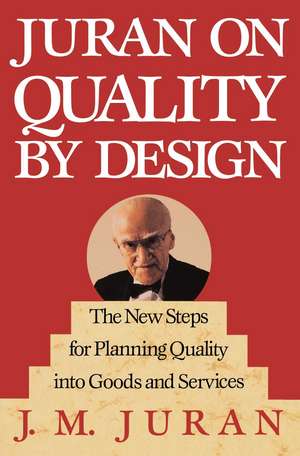Juran on Quality by Design: The New Steps for Planning Quality into Goods and Services
Autor J. M. Juranen Limba Engleză Hardback – 4 mai 1992
Quality, according to Juran, has become a prerequisite for business success. He cites the loss of market share, failure of products, and waste as results of poor quality planning. Juran provides a set of universal steps which can be used in the basic managerial process to establish quality goals, identify customers, determine customer needs, provide measurement, and develop process features and controls to improve business tactics.
The author gives new emphasis to setting quality goals, planning in "multifunctional" processes, establishing data bases for quality planning, motivating managers and the work force, and introducing quality planning into organizations.
Preț: 437.96 lei
Nou
Puncte Express: 657
Preț estimativ în valută:
83.81€ • 87.18$ • 69.19£
83.81€ • 87.18$ • 69.19£
Carte disponibilă
Livrare economică 25 martie-08 aprilie
Preluare comenzi: 021 569.72.76
Specificații
ISBN-13: 9780029166833
ISBN-10: 0029166837
Pagini: 538
Dimensiuni: 156 x 235 x 43 mm
Greutate: 0.89 kg
Ediția:Revised
Editura: Free Press
Colecția Free Press
ISBN-10: 0029166837
Pagini: 538
Dimensiuni: 156 x 235 x 43 mm
Greutate: 0.89 kg
Ediția:Revised
Editura: Free Press
Colecția Free Press
Notă biografică
J. M. Juran is the founder and Chairman Emeritus of Juran Institute, Inc. He is the author of Juran on Planning for Quality and Juran on Leadership for Quality (both Free Press) and has received over thirty awards and medals for his innovations and contributions in quality control.
Extras
Chapter 1
How to Think About Quality Planning
Purpose of This Chapter
This chapter explains why a book on quality planning is needed. It describes quality planning as a basic managerial process. It also shows the relationship of quality planning to the overall way in which companies manage for quality.
Why a Book on Quality Planning?
There are persuasive reasons for a book on quality planning. During the 1960s and 1970s many domestic U.S. companies lost their quality leadership to new, aggressive competition. The most obvious consequence was loss of market share. For example, here is a partial list of goods for which imports had gained a significant share of the North American market by 1980.
Stereo components
Medical equipment
Color television sets
Hand tools
Radial tires
Electric motors
Athletic equipment
Computer chips
Industrial robots
Electron microscopes
Machine tools
Optical equipment
The reasons for the loss in share of market were related mainly to quality, in two respects:
The imports had quality features that were perceived as better meeting customer needs.
The imports did not fail in service as often as the domestic products.
All this is pertinent to "Why a book on Quality Planning." Product features and failure rates are largely determined during planning for quality.
Loss of market share is not the only reason behind a book on planning for quality. A second major force has been the phenomenon of "life behind the quality dikes." We have learned that living in a technological society puts us at the mercy of the continuing operation of the goods and services that make such a society possible. In turn, such continuing operation depends absolutely on the quality built into those goods and services. Without such quality we have failures of all sorts: power outages, interruptions in communication and transportation, inoperative appliances. At the least these failures involve annoyances and minor costs. At their worst they are terrifying -- Chernobyl, Bhopal.
A third major force has been the gathering awareness by companies that they have been enduring excessive costs due to chronic quality-related wastes. In the U.S.A. about a third of what we do consists of redoing work previously "done." This redoing consists of correcting errors, rewriting documents, scrapping or reprocessing factory goods, responding to customer complaints, and so on.
Some managers question that figure of one-third redoing as applied to their own companies. Of course, the figure varies widely among industries, companies, and processes. However, it is easy to be led astray.
In one company, 2.4 percent of the invoices were protested by customers. To placate those customers was taking about half the time of the sales force.
In some banks only about 1.0 percent of the checks (printed with magnetic ink) fail to be processed successfully by the automated equipment. Yet it takes as much human time to process that 1 percent by hand as to process the other 99 percent by machine.
Our Quality Problems Have Been Planned That Way
Numerous specific quality crises and problems have been traced to the way in which quality was planned in the first place. In a sense, we planned it that way. There is no implication that the planners were incompetent, malicious, or otherwise deficient. On the contrary, the planners have generally been quite experienced and dedicated. Instead they faced multiple obstacles: unrealistic schedules, tight budgets, inadequate data bases. However, none of these realities diminishes the validity of the assertion that "we planned it that way." Moreover, so long as the conditions of the past remain in effect, we will continue to plan it that way.
In the factories, many product designers developed new products, and then delivered the product specifications to the Manufacturing Department. This was known as "throwing the designs over the wall," since there had been no participation by the manufacturing managers. This practice unilaterally created severe crises for the manufacturing managers.
In the offices electronic data processing opened up opportunities for processing information more promptly, and with fewer errors. However, many companies proceeded to convert their manual systems directly into electronic systems without first getting rid of the deficiencies in the manual systems. As a result, their manual mess became an automated mess.
Quality Planning Has Been Done by Amateurs
Some of those obstacles faced by the planners are beyond their control. One major obstacle, however, stems from a deficiency which the planners can remedy. That obstacle is "quality planning by amateurs," which is also a major reason for writing this book.
The question "Who does the quality planning?" has relevance to every step on the quality planning road map. What is critical is that most quality planning has been clone by amateurs -- by people who have not been trained in the use of the "quality disciplines."
All planners are faced with meeting multiple goals: a budget, a schedule, a quality specification, a mandated procedure, a government regulation, and so on. The functional planners (such as product developers) are generally experts in their function, but they lack expertise in the "quality disciplines" -- the methodology, skills, and tools required to plan for quality. Yet the planners do engage in quality planning since their goals include quality goals. Lacking expertise in the quality disciplines, they are amateurs in the best sense of that word.
Many companies have tried to deal with this problem by making quality specialists (quality engineers, reliability engineers) available to the planners as consultants. It hasn't worked very well. What has worked much better has been to train the planners themselves in use of the quality disciplines -- to train the amateurs to become professionals at quality planning.
A major decision to be made by upper managers relates to this matter of "quality planning by amateurs." The principal options are
(a) Provide the amateurs with consulting service, or
(b) Train the amateurs to become professionals.
In the experience of the authors, companies which have adopted option (b) have outperformed those who have followed option (a). The decision faced by upper managers is whether to mandate training the amateurs to become professionals.
The Mission of This Book
The mission of this book is to assist companies to achieve quality leadership through mastery of how to plan for quality. To carry out this mission, the book is organized as follows:
Chapter 1 (this chapter) defines quality planning as a universal series of steps and shows the relationship of that series to the overall way in which we manage for quality.
Chapters 2 through 8 examine that universal series in detail, step by step.
Chapters 9 through 11 show how to implement that universal series into the various levels of the company hierarchy.
The remaining chapters present supporting methodologies and case examples of planning for quality.
The Epilogue includes a discussion on "What should I do on my return?"
Figure 1-1 shows graphically how the book is organized.
The Need for Unity of Language
Managing for quality has, over the years, undergone some profound changes, especially during the 20th century. Figure 1-2 lists many of the major forces that have emerged over the years, along with the responsive strategies adopted by the impacted organizations. Inevitably such forces and responses have required revisions in language as well. For this reason we shall define key words and phrases as we go along. A good starting place is with the word "product."
Product
A product is the output of any process. The economist defines "products" as goods and services. That is also the definition adopted by this book. The term "product" includes various subclassifications:
Goods are physical things -- pencils, color television sets.
Service is work performed for someone else. Entire industries are established to provide services in such forms as central energy, transportation, communication, entertainment, and so on. Service also includes work performed for someone else within companies, e.g., payroll preparation, recruitment of new employees, plant maintenance. Such services are often called support services.
Software has more than one meaning. A major meaning is instruction programs for computers. Another major meaning is information generally: reports, plans, instructions, advice, commands.
Product Features
A product feature is a property possessed by a product that is intended to meet certain customer needs and thereby provide customer satisfaction. Product features may be technological in nature: fuel consumption of a vehicle, dimension of a mechanical component, uniformity of voltage of an electric power supply, a spelling check dictionary on an electronic typewriter. Product features may also take other forms: promptness of delivery, ease of maintenance, courtesy of service. A more technical definition of product feature is "quality characteristic."
Customer Satisfaction; Product Satisfaction
Customer satisfaction is a result achieved when product features respond to customer needs. It is generally synonymous with product satisfaction. Product satisfaction is a stimulus to product salability. The major impact is on share of market, and thereby on sales income.
Product Deficiency
A product deficiency is a product failure that results in product dissatisfaction. Product deficiencies take such forms as power outages, failures to meet delivery dates, inoperable goods, blemished appearance, or nonconformance to specification. The major impact is on the costs incurred to redo prior work, to respond to customer complaints, and so on.
Customer Dissatisfaction; Product Dissatisfaction
Product deficiencies are in all cases sources of customer dissatisfaction. This may in turn lead to specific customer reactions: complaints, returns, unfavorable publicity, lawsuits, and so on.
Product deficiencies may also cause the customer to avoid buying the product in the future despite its superior features. In this way, product salability is influenced in two ways:
The first sale to a customer is heavily influenced by the product features. At the time, the customer does not know what the product deficiencies will be.
Subsequent sales to that customer are heavily influenced by the extent of deficiencies encountered during use of the product, and by the service rendered with respect to those deficiencies.
Product Satisfaction and Product Dissatisfaction Are Not Opposites
Product satisfaction has its origin in product features and is why clients buy the product. Product dissatisfaction has its origin in non-conformances and is why customers complain. There are many products that give little or no dissatisfaction; they do what the supplier said they would do. Yet the products are not salable if some competing product provides greater product satisfaction.
For many years the copying of documents was done by use of carbon paper, "ditto" ink, "mimeograph" stencils, and so forth. The xerographic copier made all those methods obsolete because of its feature of copying documents direct from an original. Today, if someone produced a mimeograph process that was absolutely free from field failures, it would be unsalable because of its inability to copy direct from an original document.
Customer
A customer is anyone who is impacted by the product or process. Customers may be external or internal.
EXTERNAL CUSTOMERS. These are impacted by the product but are not members of the company that produces the product. External customers include clients who buy the product, government regulatory bodies, and the public (which may be impacted due to unsafe products or damage to the environment).
INTERNAL CUSTOMERS. They are impacted by the product, and are also members of the company that produces the product. They are often called "customers" despite the fact that they are not customers in the dictionary sense, that is, they are not clients.
The Meanings of Quality
The dictionary offers about a dozen definitions of the word "quality." Two of them are of major importance to managers.
Product features is one of these definitions. In the eyes of customers, the better the product features, the higher the quality.
Freedom from deficiencies is the other major definition of quality. In the eyes of customers, the fewer the deficiencies the better the quality.
Some customers, especially consumers, do not necessarily recognize that there are two rather different kinds of quality. Their vagueness may give rise to such comments as "I know it when I see it." Managers must recognize this distinction, however, since the respective impacts are on matters as diverse as salability and costs.
Figure 1-3 sets out the two definitions in more detailed form. The main lessons for the manager are:
Product features impact sales. As to this kind of quality, higher quality usually costs more.
Product deficiencies impact costs. As to this kind of quality, higher quality usually costs less.
Despite the differences in these two kinds of quality, it would be convenient to have a short, simple phrase to describe them together. To date there has been no consensus on adoption of such a phrase. The phrase "fitness for use" has gained some followers, as have some other phrases. It is unlikely that two concepts so different can be encompassed in one terse phrase.
The above definitions of quality do not meet with universal acceptance. Many companies have arrived at other definitions which they feel are consistent with the needs of their industry and with their own dialect. Their definitions often extend to the "subsets" -- the detailed ingredients contained in the broad definitions. As to these subsets there are divergent views. Figure 1-4 classifies the more usual ingredients to show how widely they are included or excluded in company definitions of quality.
There is no possibility of adoption of universal definitions until a glossary, sponsored by a recognized standardization body, has been evolved.
Big Q and Little Q
The main reason for all that inconsistency in terminology is the fact that the terminology has been changing. The change has its origin in the quality crisis, and has been so profound as to give rise to the concept of "Big Q and little Q." Figure 1-5 shows this concept in tabular form.
Until the 1980s managers generally associated quality with factories, manufactured goods, and production processes. During the 1980s there emerged a wide trend to broaden the definition of quality to include the contents shown in Figure 1-5. The willingness to accept this trend has varied. Those most willing have been the quality managers and the upper managers. Those most reluctant have been managers in the technological areas and in certain staff functions, such as finance and human relations.
The Conformance Definition: Limitations and Merits
Some companies have defined quality in terms such as conformance to specification, or conformance to standards. These are dangerous definitions when applied at managerial levels. At those levels what is essential is that the products respond to customer needs. Conformance to standards is only one of many means to that end.
Conformance by its nature relates to static standards and specifications, whereas quality is a moving target. Many standards include provision for chronic wastes. Defining quality as conformance helps to perpetuate those wastes. For some qualities, 100 percent conformance means defect-free product. That is a useful goal, but what produces salability is product features that respond to customer needs.
In New York City a builder erected a building which ended up about 814 feet high. The height authorized by the permit was 803 feet. The builder asserted that the extra height was mainly the result of thickening each floor slab in order to increase the stability of the building. No additional floors or floor space were gained. However, the New York City Planning Commission refused to approve the structure on the grounds that the extra height would not "relate harmoniously to all structures or open space in the vicinity in terms of scale, location and access to light and air."
The conformance definition does have a place -- in the lower levels of the company. In those levels the personnel are often unaware of what customer needs are. (Some are unaware that they have customers). Nevertheless these same people require clear definitions of their responsibility with respect to quality. One way of defining those responsibilities is to provide them with specifications and procedures. The responsibilities then become to follow the procedures and to meet the specifications.
As is evident, the conformance definition is the traditional form -- straight out of little Q.
Planning and Quality Planning
As used in this book, planning is the activity of (a) establishing goals, and (b) establishing the means required to meet those goals. When this definition is applied to quality, the result is:
Quality planning is the activity of (a) establishing quality goals and (b) developing the products and processes required to meet those goals.
In using this definition, note that quality planning is required for numerous products, not only the goods and services sold to clients, but also many internal products: purchase orders, invoices, reports. Quality planning is also required for numerous processes, many of which are internal business processes, e.g., recruitment of new employees, preparing sales forecasts, producing the invoices.
Explaining Quality Planning to Upper Management
Earlier in this chapter we saw that most quality planning has been done by amateurs. These amateurs have included the upper managers. To convert those amateurs into professionals is a cultural change which requires the active participation of the upper managers. As a prerequisite it is necessary to explain to upper managers how to think about quality and quality planning. We have learned from experience that making such an explanation becomes simplified if we make use of a financial analogy. The explanation starts by first looking at how upper managers manage for finance. That answer is obvious -- financial management is carried out by the use of three managerial processes:
FINANCIAL PLANNING. This planning is centered on preparation of the annual financial budget. In turn, this preparation involves a companywide process that starts by proposing the financial goals to be reached in the year ahead. These goals are then "deployed" in order to identify the deeds that must be done to reach the goals. The deeds are then translated into money equivalents. Such translation permits summary and analysis to determine the financial consequences of doing all those deeds. The resulting budget is a publication of the financial goals for the company and its various divisions and departments.
FINANCIAL CONTROL. This well-known process is used to aid managers in reaching the established financial goals. The process consists of evaluating actual financial performance; comparing this with financial goals; and taking action on the difference -- the accountant's "variance." There are numerous subprocesses for financial control: cost control, expense control, inventory control, and so on.
FINANCIAL IMPROVEMENT. This process takes many forms: cost reduction projects, purchase of new facilities to improve productivity, speeding up the invoicing process, development of new products to increase sales, acquisition of other companies, and others.
The Juran Trilogy®
Managing for quality is done by use of the same three managerial processes of planning, control and improvement. Now the names change to:
Quality planning
Quality control
Quality improvement
d
We shall refer to these three processes as The Juran Trilogy (for elaboration, see Juran, 1986). Conceptually these processes are identical with those used to manage for finance. However, the procedural steps are special, and the tools used are also special.
QUALITY PLANNING. This is the activity of developing the products and processes required to meet customers' needs. It involves a series of universal steps which can be abbreviated as follows:
Establish quality goals
Identify the customers -- those who will be impacted by the efforts to meet the goals
Determine the customers' needs
Develop product features that respond to customers' needs
Develop processes that are able to produce those product features
Establish process controls, and transfer the resulting plans to the operating forces
We shall look at this process in detail during the remainder of this book.
QUALITY CONTROL. This process consists of the following steps:
Evaluate actual quality performance
Compare actual performance to quality goals
Act on the difference
QUALITY IMPROVEMENT. This process is the means of raising quality performance to unprecedented levels ("breakthrough") The methodology consists of a series of universal steps:
Establish the infrastructure needed to secure annual quality improvement
Identify the specific needs for improvement -- the improvement projects
For each project establish a project team with clear responsibility for bringing the project to a successful conclusion
Provide the resources, motivation, and training needed by the teams to:
Diagnose the causes
Stimulate establishment of remedies
Establish controls to hold the gains
Three Universal Sequences
Notice that each of those three processes has been generalized into a universal sequence of steps. Those same three universal sequences have been discovered and rediscovered, over and over again, by practicing managers. Figure 1-6 shows these sequences in abbreviated form.
The Juran Trilogy Diagram
The Trilogy concept is not merely a way to explain managing for quality to upper management. It is also a unifying concept which extends companywide. Every function has unique features, as does every product or process. Yet for every one of them, we manage for quality using the same three generic processes of the Trilogy: planning, control, and improvement.
The three processes of the Trilogy are interrelated. Figure 1-7, The Juran Trilogy Diagram, shows this interrelationship.
Figure 1-7 is a graph with time on the horizontal axis and cost of poor quality (quality deficiencies) on the vertical axis. The initial activity is quality planning. The planners determine who are the customers and what are their needs. The planners then develop product and process designs that are able to respond to those needs. Finally, the planners turn the plans over to the operating forces.
The job of the operating forces is to run the processes and produce the products. As operations proceed it soon emerges that the process is unable to produce 100 percent good work. Figure 1-7 shows that 20 percent of the work must be redone because of quality deficiencies. This waste then becomes chronic, because it was planned that way.
Under conventional responsibility patterns the operating forces are unable to get rid of that planned chronic waste. What they do instead is to carry out quality control -- to prevent things from getting worse. Control includes putting out the fires, such as that sporadic spike.
Figure 1-7 also shows that in due course the chronic waste was driven down to a level far below the level that had been planned originally. That gain was achieved by the third process in the Trilogy, "quality improvement." In effect, it was realized that the chronic waste was also an opportunity for improvement. So steps were taken to seize that opportunity.
The Juran Trilogy Diagram and Product Deficiencies
The Trilogy diagram (Figure 1-7) relates to product deficiencies. The vertical scale therefore exhibits such units of measure as cost of poor quality, error rate, percent defective, and service call rate. On this same scale, perfection is at zero. What goes up is bad.
The result of reducing product deficiencies has been to reduce the cost of poor quality, meet more delivery promises, and reduce customer dissatisfaction.
The Trilogy Diagram and Product Features
When the Trilogy diagram is applied to product features, the vertical scale changes. Now the scale exhibits units of measure for such features as:
Rated hours of life
Millions of instructions per second
Load-carrying capacity
Mean time between failures
For the above features, what goes up is good. For certain other product features, what goes up is bad. For example:
Waiting time in queues
Power consumption
Maintenance hours per 1,000 operating hours
Time to restore service
For ease in interpreting the diagrams, we shall label the vertical scales as follows:
For quality deficiencies we shall label the vertical scale "Cost of Poor Quality." In such diagrams what goes up is bad. An example is Figure 1-7.
For quality features we shall label the vertical scale "Product Salability." In such diagrams what goes up is good.
An example of using product salability as the vertical scale is the well-known model of the trends of Japanese versus Western quality (Figure 1-8). This diagram has been helpful in demonstrating to managers the importance of maintaining a high rate of improvement, year after year (Juran, 1981; 1985).
Quality Planning Distinguished from Quality Control
This distinction is fairly obvious. Quality planning deals with setting goals and with establishing the means required to reach those goals. Quality control deals with execution of plans -- conducting operations so as to meet the goals. Quality control includes monitoring operations so as to detect differences between actual performance and goals. (The accountant's term for such differences is "variances".) In addition, quality control includes taking action (firefighting) to restore the status quo in the event that variances do appear.
Quality Planning Distinguished from Quality Improvement
This distinction is best brought out by the alligator analogy -- the plight of the fabled manager who was up to his waist in alligators. Under that analogy each live alligator is a chronic waste, a potential quality improvement project. Each completed improvement project results in a dead alligator.
If our fabled manager succeeded in exterminating all alligators, then quality improvement would be complete -- for the moment. However the manager would not be finished with alligators. The reason is that the planning process has not changed.
In effect, the quality planning process is a dual hatchery. A benign hatchery produces new, useful quality plans. A malignant hatchery produces new alligators. Quality improvement can take care of the existing alligators, one by one. To stop the production of new alligators, however, requires shutting down that malignant hatchery.
How to Shut Down the Hatchery
Shutting down that hatchery requires an array of remedies, all of which involve changes in the quality planning process.
There are also differences in the basics. Quality improvement is directed at chronic problems, requiring diagnosis to discover the causes and providing remedies to get rid of the causes. Quality planning is directed at meeting customer-oriented goals, requiring application of the quality planning road map (Figure 1-9).
(There are also some commonalities. For many quality improvement projects the remedy consists of replanning. In addition, certain skills and tools are common to both processes).
The Quality Planning Road Map
We saw in Figure 1-6 that quality planning is done by a universal series of steps. If we expand Figure 1-6 into a series of input-output diagrams, and also include the activity of measurement, the result is Figure 1-9.
We shall refer to Figure 1-9 as the quality planning road map. The next few chapters will follow that road map, step by step.
In Figure 1-9 the steps are shown in their usual chronological sequence. However, the measurement step is off to the side in order to show that it applies to all the planning steps. The steps of the quality road map are stitched together by several commonalities:
1. The interlocking input-output chain, in which the output for any step becomes the input for the next step
2. A series of spreadsheets (see Figure 1-10), which make the details of the interrelationships readily understandable and accessible
3. A common, coherent system of measurement -- units of measure and sensors -- which applies to each step as well as to the entire sequence
4. A triple role concept, under which every activity involves the triple role of customer, processor, and supplier (see below).
It may seem surprising that one such road map is so universal -- that it can provide directions for planning a very wide range of products and processes. Yet such is the case. Many practicing managers have invented and reinvented similar road maps. Many company procedures include similar road maps for specific products or processes. That road map has been field tested, extensively. That same road map becomes our guide for the rest of this book.
Not Always Consecutive
The road map shows the planning steps taking place in a consecutive manner, each step following the previous one chronologically. Such an approach can do a lot of damage unless provision is made for participation, early warning, joint planning, and so on. The most complete of such provisions is often called concurrent planning. It makes use of a broad-based planning team that is working on all the steps, but concurrently instead of consecutively.
Quality Planning Spreadsheets
As quality planning progresses, it collects a great deal of information. There are many customers, each with multiple needs. Many product features are required to meet those needs, and many process features are required to produce those product features. The resulting combinations are so numerous that it becomes necessary to establish a structured means of organizing the information for ready interpretation and access. The most widely used structure is a multidimensional table called a spreadsheet.
There are many types of spreadsheets, but four types dominate the use of spreadsheets in quality planning. Figures 1-10a through 1-10d shows these dominant spreadsheets in their generic form.
In Figure 1-10a the horizontal rows list the various customers. The vertical columns show the needs of those customers. The intersections are codemarked to show the degrees of relationship between customers and needs.
In Figure 1-10b the customer needs have been moved to the horizontal rows. The vertical columns are then used to show the product features required to meet those customer needs.
In Figure 1-10c the product features have been moved to the horizontal rows. The vertical columns are then used to show the process features required to produce those product features.
Finally in Figure 1-10d the process features have been moved to the horizontal rows. The vertical columns are then used to show the process control features required to keep the processes in a steady state.
The Triple Role Concept
Every unit of the organization -- the entire company, each division, each department, each person -- carries out a process and produces a product. We shall call any such unit a processor team. Each processor team carries out three quality-related roles, which are depicted in Figure 1-11 -- the TRIPROL™ diagram.
The TRIPROL diagram shows the interrelationship among three roles:
Customer. The processor team acquires various kinds of inputs which are used in carrying out the process. The processor team is a customer of the suppliers who provide the inputs.
Processor. The processor team carries out various managerial and technological activities in order to produce its products.
Supplier. The processor team supplies its products to its customers.
The concept of the triple role is simple enough. However, the application can become quite complex because of the presence of large numbers of suppliers, inputs, processes, products, and customers. The greater the complexity, the greater the need for an orderly, structured approach to quality planning. The backbone of this structure is the quality planning road map. The memory system is the spreadsheets.
The Roles of Upper Managers
As we work our way down the quality planning road map, we shall encounter various stages at which specific decisions and actions are faced by upper managers. We will identify these by an action symbol consisting of a stylized triangle representing an organization pyramid. Each chapter will identify the managerial action items appropriate to that chapter. These same action items will then be summarized at the end of the respective chapters. In addition, the Epilogue will include an edited version of the action items collectively.
It is now clear that upper managers have a vital role to play in the quality planning process. This role requires extensive personal participation. It cannot be delegated, since a major change in company culture is needed. During the 1980s many upper managers adopted strategies that involved setting vague goals and then delegating to the rest of the organization the responsibility for meeting those vague goals. The most usual results were a loss of several years, a residue of divisiveness, and a loss of credibility.
Relative to the subject matter of this chapter, a role for upper managers is that of reducing confusion in the company by standardizing the meanings of the key terms that pertain to managing for quality. An effective way to do this is to assign a team to:
Identify the key terms for which standardized definitions could significantly improve communication
Develop agreed definitions for these key terms
Publish the agreed definitions in an official glossary
On to the Quality Planning Road Map
This chapter has explained why a book on quality planning is needed. It has also explained how to think about quality and has generalized the quality planning process -- the quality planning road map.
During the next few chapters, we shall follow that road map, step by step. The first of those steps is Establish Quality Goals. That is the subject of the next chapter.
High Points in Chapters
Each chapter of this book will conclude with a summary of the high points of that chapter. Those high points should be among the focal points for in-house training. A second summary will list the nominations of specific actions to be taken by managers.
List of High Points
Product features and failure rates are largely determined during planning for quality.
In the United States about a third of what we do consists of redoing work previously "done."
Our quality problems have been planned that way.
Most quality planning has been done by amateurs.
What has worked well has been to train the amateurs to become professionals at quality planning.
Product satisfaction and product dissatisfaction are not opposites.
Product features impact sales. As to this kind of quality, higher quality usually costs more.
Product deficiencies impact costs. As to this kind of quality, higher quality usually costs less.
The concept of "Big Q" is replacing that of "little Q."
Managing for quality is done by use of three managerial processes: quality planning, quality control, and quality improvement.
Quality planning is the activity of (a) establishing quality goals and (b) developing the products and processes required to meet those goals.
To stop the production of new alligators requires shutting down the alligator hatchery.
Quality planning is done by a universal series of steps -- the quality planning road map.
Upper managers have a vital role to play in the quality planning process.
Tasks for Upper Managers
Assign a team to prepare and publish agreed definitions for the key terms relating to managing for quality.
Decide whether to mandate training the planners, who are typically amateurs in matters of quality, to become professionals.
Copyright © 1992 by Juran Institute, Inc.
How to Think About Quality Planning
Purpose of This Chapter
This chapter explains why a book on quality planning is needed. It describes quality planning as a basic managerial process. It also shows the relationship of quality planning to the overall way in which companies manage for quality.
Why a Book on Quality Planning?
There are persuasive reasons for a book on quality planning. During the 1960s and 1970s many domestic U.S. companies lost their quality leadership to new, aggressive competition. The most obvious consequence was loss of market share. For example, here is a partial list of goods for which imports had gained a significant share of the North American market by 1980.
Stereo components
Medical equipment
Color television sets
Hand tools
Radial tires
Electric motors
Athletic equipment
Computer chips
Industrial robots
Electron microscopes
Machine tools
Optical equipment
The reasons for the loss in share of market were related mainly to quality, in two respects:
The imports had quality features that were perceived as better meeting customer needs.
The imports did not fail in service as often as the domestic products.
All this is pertinent to "Why a book on Quality Planning." Product features and failure rates are largely determined during planning for quality.
Loss of market share is not the only reason behind a book on planning for quality. A second major force has been the phenomenon of "life behind the quality dikes." We have learned that living in a technological society puts us at the mercy of the continuing operation of the goods and services that make such a society possible. In turn, such continuing operation depends absolutely on the quality built into those goods and services. Without such quality we have failures of all sorts: power outages, interruptions in communication and transportation, inoperative appliances. At the least these failures involve annoyances and minor costs. At their worst they are terrifying -- Chernobyl, Bhopal.
A third major force has been the gathering awareness by companies that they have been enduring excessive costs due to chronic quality-related wastes. In the U.S.A. about a third of what we do consists of redoing work previously "done." This redoing consists of correcting errors, rewriting documents, scrapping or reprocessing factory goods, responding to customer complaints, and so on.
Some managers question that figure of one-third redoing as applied to their own companies. Of course, the figure varies widely among industries, companies, and processes. However, it is easy to be led astray.
In one company, 2.4 percent of the invoices were protested by customers. To placate those customers was taking about half the time of the sales force.
In some banks only about 1.0 percent of the checks (printed with magnetic ink) fail to be processed successfully by the automated equipment. Yet it takes as much human time to process that 1 percent by hand as to process the other 99 percent by machine.
Our Quality Problems Have Been Planned That Way
Numerous specific quality crises and problems have been traced to the way in which quality was planned in the first place. In a sense, we planned it that way. There is no implication that the planners were incompetent, malicious, or otherwise deficient. On the contrary, the planners have generally been quite experienced and dedicated. Instead they faced multiple obstacles: unrealistic schedules, tight budgets, inadequate data bases. However, none of these realities diminishes the validity of the assertion that "we planned it that way." Moreover, so long as the conditions of the past remain in effect, we will continue to plan it that way.
In the factories, many product designers developed new products, and then delivered the product specifications to the Manufacturing Department. This was known as "throwing the designs over the wall," since there had been no participation by the manufacturing managers. This practice unilaterally created severe crises for the manufacturing managers.
In the offices electronic data processing opened up opportunities for processing information more promptly, and with fewer errors. However, many companies proceeded to convert their manual systems directly into electronic systems without first getting rid of the deficiencies in the manual systems. As a result, their manual mess became an automated mess.
Quality Planning Has Been Done by Amateurs
Some of those obstacles faced by the planners are beyond their control. One major obstacle, however, stems from a deficiency which the planners can remedy. That obstacle is "quality planning by amateurs," which is also a major reason for writing this book.
The question "Who does the quality planning?" has relevance to every step on the quality planning road map. What is critical is that most quality planning has been clone by amateurs -- by people who have not been trained in the use of the "quality disciplines."
All planners are faced with meeting multiple goals: a budget, a schedule, a quality specification, a mandated procedure, a government regulation, and so on. The functional planners (such as product developers) are generally experts in their function, but they lack expertise in the "quality disciplines" -- the methodology, skills, and tools required to plan for quality. Yet the planners do engage in quality planning since their goals include quality goals. Lacking expertise in the quality disciplines, they are amateurs in the best sense of that word.
Many companies have tried to deal with this problem by making quality specialists (quality engineers, reliability engineers) available to the planners as consultants. It hasn't worked very well. What has worked much better has been to train the planners themselves in use of the quality disciplines -- to train the amateurs to become professionals at quality planning.
A major decision to be made by upper managers relates to this matter of "quality planning by amateurs." The principal options are
(a) Provide the amateurs with consulting service, or
(b) Train the amateurs to become professionals.
In the experience of the authors, companies which have adopted option (b) have outperformed those who have followed option (a). The decision faced by upper managers is whether to mandate training the amateurs to become professionals.
The Mission of This Book
The mission of this book is to assist companies to achieve quality leadership through mastery of how to plan for quality. To carry out this mission, the book is organized as follows:
Chapter 1 (this chapter) defines quality planning as a universal series of steps and shows the relationship of that series to the overall way in which we manage for quality.
Chapters 2 through 8 examine that universal series in detail, step by step.
Chapters 9 through 11 show how to implement that universal series into the various levels of the company hierarchy.
The remaining chapters present supporting methodologies and case examples of planning for quality.
The Epilogue includes a discussion on "What should I do on my return?"
Figure 1-1 shows graphically how the book is organized.
The Need for Unity of Language
Managing for quality has, over the years, undergone some profound changes, especially during the 20th century. Figure 1-2 lists many of the major forces that have emerged over the years, along with the responsive strategies adopted by the impacted organizations. Inevitably such forces and responses have required revisions in language as well. For this reason we shall define key words and phrases as we go along. A good starting place is with the word "product."
Product
A product is the output of any process. The economist defines "products" as goods and services. That is also the definition adopted by this book. The term "product" includes various subclassifications:
Goods are physical things -- pencils, color television sets.
Service is work performed for someone else. Entire industries are established to provide services in such forms as central energy, transportation, communication, entertainment, and so on. Service also includes work performed for someone else within companies, e.g., payroll preparation, recruitment of new employees, plant maintenance. Such services are often called support services.
Software has more than one meaning. A major meaning is instruction programs for computers. Another major meaning is information generally: reports, plans, instructions, advice, commands.
Product Features
A product feature is a property possessed by a product that is intended to meet certain customer needs and thereby provide customer satisfaction. Product features may be technological in nature: fuel consumption of a vehicle, dimension of a mechanical component, uniformity of voltage of an electric power supply, a spelling check dictionary on an electronic typewriter. Product features may also take other forms: promptness of delivery, ease of maintenance, courtesy of service. A more technical definition of product feature is "quality characteristic."
Customer Satisfaction; Product Satisfaction
Customer satisfaction is a result achieved when product features respond to customer needs. It is generally synonymous with product satisfaction. Product satisfaction is a stimulus to product salability. The major impact is on share of market, and thereby on sales income.
Product Deficiency
A product deficiency is a product failure that results in product dissatisfaction. Product deficiencies take such forms as power outages, failures to meet delivery dates, inoperable goods, blemished appearance, or nonconformance to specification. The major impact is on the costs incurred to redo prior work, to respond to customer complaints, and so on.
Customer Dissatisfaction; Product Dissatisfaction
Product deficiencies are in all cases sources of customer dissatisfaction. This may in turn lead to specific customer reactions: complaints, returns, unfavorable publicity, lawsuits, and so on.
Product deficiencies may also cause the customer to avoid buying the product in the future despite its superior features. In this way, product salability is influenced in two ways:
The first sale to a customer is heavily influenced by the product features. At the time, the customer does not know what the product deficiencies will be.
Subsequent sales to that customer are heavily influenced by the extent of deficiencies encountered during use of the product, and by the service rendered with respect to those deficiencies.
Product Satisfaction and Product Dissatisfaction Are Not Opposites
Product satisfaction has its origin in product features and is why clients buy the product. Product dissatisfaction has its origin in non-conformances and is why customers complain. There are many products that give little or no dissatisfaction; they do what the supplier said they would do. Yet the products are not salable if some competing product provides greater product satisfaction.
For many years the copying of documents was done by use of carbon paper, "ditto" ink, "mimeograph" stencils, and so forth. The xerographic copier made all those methods obsolete because of its feature of copying documents direct from an original. Today, if someone produced a mimeograph process that was absolutely free from field failures, it would be unsalable because of its inability to copy direct from an original document.
Customer
A customer is anyone who is impacted by the product or process. Customers may be external or internal.
EXTERNAL CUSTOMERS. These are impacted by the product but are not members of the company that produces the product. External customers include clients who buy the product, government regulatory bodies, and the public (which may be impacted due to unsafe products or damage to the environment).
INTERNAL CUSTOMERS. They are impacted by the product, and are also members of the company that produces the product. They are often called "customers" despite the fact that they are not customers in the dictionary sense, that is, they are not clients.
The Meanings of Quality
The dictionary offers about a dozen definitions of the word "quality." Two of them are of major importance to managers.
Product features is one of these definitions. In the eyes of customers, the better the product features, the higher the quality.
Freedom from deficiencies is the other major definition of quality. In the eyes of customers, the fewer the deficiencies the better the quality.
Some customers, especially consumers, do not necessarily recognize that there are two rather different kinds of quality. Their vagueness may give rise to such comments as "I know it when I see it." Managers must recognize this distinction, however, since the respective impacts are on matters as diverse as salability and costs.
Figure 1-3 sets out the two definitions in more detailed form. The main lessons for the manager are:
Product features impact sales. As to this kind of quality, higher quality usually costs more.
Product deficiencies impact costs. As to this kind of quality, higher quality usually costs less.
Despite the differences in these two kinds of quality, it would be convenient to have a short, simple phrase to describe them together. To date there has been no consensus on adoption of such a phrase. The phrase "fitness for use" has gained some followers, as have some other phrases. It is unlikely that two concepts so different can be encompassed in one terse phrase.
The above definitions of quality do not meet with universal acceptance. Many companies have arrived at other definitions which they feel are consistent with the needs of their industry and with their own dialect. Their definitions often extend to the "subsets" -- the detailed ingredients contained in the broad definitions. As to these subsets there are divergent views. Figure 1-4 classifies the more usual ingredients to show how widely they are included or excluded in company definitions of quality.
There is no possibility of adoption of universal definitions until a glossary, sponsored by a recognized standardization body, has been evolved.
Big Q and Little Q
The main reason for all that inconsistency in terminology is the fact that the terminology has been changing. The change has its origin in the quality crisis, and has been so profound as to give rise to the concept of "Big Q and little Q." Figure 1-5 shows this concept in tabular form.
Until the 1980s managers generally associated quality with factories, manufactured goods, and production processes. During the 1980s there emerged a wide trend to broaden the definition of quality to include the contents shown in Figure 1-5. The willingness to accept this trend has varied. Those most willing have been the quality managers and the upper managers. Those most reluctant have been managers in the technological areas and in certain staff functions, such as finance and human relations.
The Conformance Definition: Limitations and Merits
Some companies have defined quality in terms such as conformance to specification, or conformance to standards. These are dangerous definitions when applied at managerial levels. At those levels what is essential is that the products respond to customer needs. Conformance to standards is only one of many means to that end.
Conformance by its nature relates to static standards and specifications, whereas quality is a moving target. Many standards include provision for chronic wastes. Defining quality as conformance helps to perpetuate those wastes. For some qualities, 100 percent conformance means defect-free product. That is a useful goal, but what produces salability is product features that respond to customer needs.
In New York City a builder erected a building which ended up about 814 feet high. The height authorized by the permit was 803 feet. The builder asserted that the extra height was mainly the result of thickening each floor slab in order to increase the stability of the building. No additional floors or floor space were gained. However, the New York City Planning Commission refused to approve the structure on the grounds that the extra height would not "relate harmoniously to all structures or open space in the vicinity in terms of scale, location and access to light and air."
The conformance definition does have a place -- in the lower levels of the company. In those levels the personnel are often unaware of what customer needs are. (Some are unaware that they have customers). Nevertheless these same people require clear definitions of their responsibility with respect to quality. One way of defining those responsibilities is to provide them with specifications and procedures. The responsibilities then become to follow the procedures and to meet the specifications.
As is evident, the conformance definition is the traditional form -- straight out of little Q.
Planning and Quality Planning
As used in this book, planning is the activity of (a) establishing goals, and (b) establishing the means required to meet those goals. When this definition is applied to quality, the result is:
Quality planning is the activity of (a) establishing quality goals and (b) developing the products and processes required to meet those goals.
In using this definition, note that quality planning is required for numerous products, not only the goods and services sold to clients, but also many internal products: purchase orders, invoices, reports. Quality planning is also required for numerous processes, many of which are internal business processes, e.g., recruitment of new employees, preparing sales forecasts, producing the invoices.
Explaining Quality Planning to Upper Management
Earlier in this chapter we saw that most quality planning has been done by amateurs. These amateurs have included the upper managers. To convert those amateurs into professionals is a cultural change which requires the active participation of the upper managers. As a prerequisite it is necessary to explain to upper managers how to think about quality and quality planning. We have learned from experience that making such an explanation becomes simplified if we make use of a financial analogy. The explanation starts by first looking at how upper managers manage for finance. That answer is obvious -- financial management is carried out by the use of three managerial processes:
FINANCIAL PLANNING. This planning is centered on preparation of the annual financial budget. In turn, this preparation involves a companywide process that starts by proposing the financial goals to be reached in the year ahead. These goals are then "deployed" in order to identify the deeds that must be done to reach the goals. The deeds are then translated into money equivalents. Such translation permits summary and analysis to determine the financial consequences of doing all those deeds. The resulting budget is a publication of the financial goals for the company and its various divisions and departments.
FINANCIAL CONTROL. This well-known process is used to aid managers in reaching the established financial goals. The process consists of evaluating actual financial performance; comparing this with financial goals; and taking action on the difference -- the accountant's "variance." There are numerous subprocesses for financial control: cost control, expense control, inventory control, and so on.
FINANCIAL IMPROVEMENT. This process takes many forms: cost reduction projects, purchase of new facilities to improve productivity, speeding up the invoicing process, development of new products to increase sales, acquisition of other companies, and others.
The Juran Trilogy®
Managing for quality is done by use of the same three managerial processes of planning, control and improvement. Now the names change to:
Quality planning
Quality control
Quality improvement
d
We shall refer to these three processes as The Juran Trilogy (for elaboration, see Juran, 1986). Conceptually these processes are identical with those used to manage for finance. However, the procedural steps are special, and the tools used are also special.
QUALITY PLANNING. This is the activity of developing the products and processes required to meet customers' needs. It involves a series of universal steps which can be abbreviated as follows:
Establish quality goals
Identify the customers -- those who will be impacted by the efforts to meet the goals
Determine the customers' needs
Develop product features that respond to customers' needs
Develop processes that are able to produce those product features
Establish process controls, and transfer the resulting plans to the operating forces
We shall look at this process in detail during the remainder of this book.
QUALITY CONTROL. This process consists of the following steps:
Evaluate actual quality performance
Compare actual performance to quality goals
Act on the difference
QUALITY IMPROVEMENT. This process is the means of raising quality performance to unprecedented levels ("breakthrough") The methodology consists of a series of universal steps:
Establish the infrastructure needed to secure annual quality improvement
Identify the specific needs for improvement -- the improvement projects
For each project establish a project team with clear responsibility for bringing the project to a successful conclusion
Provide the resources, motivation, and training needed by the teams to:
Diagnose the causes
Stimulate establishment of remedies
Establish controls to hold the gains
Three Universal Sequences
Notice that each of those three processes has been generalized into a universal sequence of steps. Those same three universal sequences have been discovered and rediscovered, over and over again, by practicing managers. Figure 1-6 shows these sequences in abbreviated form.
The Juran Trilogy Diagram
The Trilogy concept is not merely a way to explain managing for quality to upper management. It is also a unifying concept which extends companywide. Every function has unique features, as does every product or process. Yet for every one of them, we manage for quality using the same three generic processes of the Trilogy: planning, control, and improvement.
The three processes of the Trilogy are interrelated. Figure 1-7, The Juran Trilogy Diagram, shows this interrelationship.
Figure 1-7 is a graph with time on the horizontal axis and cost of poor quality (quality deficiencies) on the vertical axis. The initial activity is quality planning. The planners determine who are the customers and what are their needs. The planners then develop product and process designs that are able to respond to those needs. Finally, the planners turn the plans over to the operating forces.
The job of the operating forces is to run the processes and produce the products. As operations proceed it soon emerges that the process is unable to produce 100 percent good work. Figure 1-7 shows that 20 percent of the work must be redone because of quality deficiencies. This waste then becomes chronic, because it was planned that way.
Under conventional responsibility patterns the operating forces are unable to get rid of that planned chronic waste. What they do instead is to carry out quality control -- to prevent things from getting worse. Control includes putting out the fires, such as that sporadic spike.
Figure 1-7 also shows that in due course the chronic waste was driven down to a level far below the level that had been planned originally. That gain was achieved by the third process in the Trilogy, "quality improvement." In effect, it was realized that the chronic waste was also an opportunity for improvement. So steps were taken to seize that opportunity.
The Juran Trilogy Diagram and Product Deficiencies
The Trilogy diagram (Figure 1-7) relates to product deficiencies. The vertical scale therefore exhibits such units of measure as cost of poor quality, error rate, percent defective, and service call rate. On this same scale, perfection is at zero. What goes up is bad.
The result of reducing product deficiencies has been to reduce the cost of poor quality, meet more delivery promises, and reduce customer dissatisfaction.
The Trilogy Diagram and Product Features
When the Trilogy diagram is applied to product features, the vertical scale changes. Now the scale exhibits units of measure for such features as:
Rated hours of life
Millions of instructions per second
Load-carrying capacity
Mean time between failures
For the above features, what goes up is good. For certain other product features, what goes up is bad. For example:
Waiting time in queues
Power consumption
Maintenance hours per 1,000 operating hours
Time to restore service
For ease in interpreting the diagrams, we shall label the vertical scales as follows:
For quality deficiencies we shall label the vertical scale "Cost of Poor Quality." In such diagrams what goes up is bad. An example is Figure 1-7.
For quality features we shall label the vertical scale "Product Salability." In such diagrams what goes up is good.
An example of using product salability as the vertical scale is the well-known model of the trends of Japanese versus Western quality (Figure 1-8). This diagram has been helpful in demonstrating to managers the importance of maintaining a high rate of improvement, year after year (Juran, 1981; 1985).
Quality Planning Distinguished from Quality Control
This distinction is fairly obvious. Quality planning deals with setting goals and with establishing the means required to reach those goals. Quality control deals with execution of plans -- conducting operations so as to meet the goals. Quality control includes monitoring operations so as to detect differences between actual performance and goals. (The accountant's term for such differences is "variances".) In addition, quality control includes taking action (firefighting) to restore the status quo in the event that variances do appear.
Quality Planning Distinguished from Quality Improvement
This distinction is best brought out by the alligator analogy -- the plight of the fabled manager who was up to his waist in alligators. Under that analogy each live alligator is a chronic waste, a potential quality improvement project. Each completed improvement project results in a dead alligator.
If our fabled manager succeeded in exterminating all alligators, then quality improvement would be complete -- for the moment. However the manager would not be finished with alligators. The reason is that the planning process has not changed.
In effect, the quality planning process is a dual hatchery. A benign hatchery produces new, useful quality plans. A malignant hatchery produces new alligators. Quality improvement can take care of the existing alligators, one by one. To stop the production of new alligators, however, requires shutting down that malignant hatchery.
How to Shut Down the Hatchery
Shutting down that hatchery requires an array of remedies, all of which involve changes in the quality planning process.
There are also differences in the basics. Quality improvement is directed at chronic problems, requiring diagnosis to discover the causes and providing remedies to get rid of the causes. Quality planning is directed at meeting customer-oriented goals, requiring application of the quality planning road map (Figure 1-9).
(There are also some commonalities. For many quality improvement projects the remedy consists of replanning. In addition, certain skills and tools are common to both processes).
The Quality Planning Road Map
We saw in Figure 1-6 that quality planning is done by a universal series of steps. If we expand Figure 1-6 into a series of input-output diagrams, and also include the activity of measurement, the result is Figure 1-9.
We shall refer to Figure 1-9 as the quality planning road map. The next few chapters will follow that road map, step by step.
In Figure 1-9 the steps are shown in their usual chronological sequence. However, the measurement step is off to the side in order to show that it applies to all the planning steps. The steps of the quality road map are stitched together by several commonalities:
1. The interlocking input-output chain, in which the output for any step becomes the input for the next step
2. A series of spreadsheets (see Figure 1-10), which make the details of the interrelationships readily understandable and accessible
3. A common, coherent system of measurement -- units of measure and sensors -- which applies to each step as well as to the entire sequence
4. A triple role concept, under which every activity involves the triple role of customer, processor, and supplier (see below).
It may seem surprising that one such road map is so universal -- that it can provide directions for planning a very wide range of products and processes. Yet such is the case. Many practicing managers have invented and reinvented similar road maps. Many company procedures include similar road maps for specific products or processes. That road map has been field tested, extensively. That same road map becomes our guide for the rest of this book.
Not Always Consecutive
The road map shows the planning steps taking place in a consecutive manner, each step following the previous one chronologically. Such an approach can do a lot of damage unless provision is made for participation, early warning, joint planning, and so on. The most complete of such provisions is often called concurrent planning. It makes use of a broad-based planning team that is working on all the steps, but concurrently instead of consecutively.
Quality Planning Spreadsheets
As quality planning progresses, it collects a great deal of information. There are many customers, each with multiple needs. Many product features are required to meet those needs, and many process features are required to produce those product features. The resulting combinations are so numerous that it becomes necessary to establish a structured means of organizing the information for ready interpretation and access. The most widely used structure is a multidimensional table called a spreadsheet.
There are many types of spreadsheets, but four types dominate the use of spreadsheets in quality planning. Figures 1-10a through 1-10d shows these dominant spreadsheets in their generic form.
In Figure 1-10a the horizontal rows list the various customers. The vertical columns show the needs of those customers. The intersections are codemarked to show the degrees of relationship between customers and needs.
In Figure 1-10b the customer needs have been moved to the horizontal rows. The vertical columns are then used to show the product features required to meet those customer needs.
In Figure 1-10c the product features have been moved to the horizontal rows. The vertical columns are then used to show the process features required to produce those product features.
Finally in Figure 1-10d the process features have been moved to the horizontal rows. The vertical columns are then used to show the process control features required to keep the processes in a steady state.
The Triple Role Concept
Every unit of the organization -- the entire company, each division, each department, each person -- carries out a process and produces a product. We shall call any such unit a processor team. Each processor team carries out three quality-related roles, which are depicted in Figure 1-11 -- the TRIPROL™ diagram.
The TRIPROL diagram shows the interrelationship among three roles:
Customer. The processor team acquires various kinds of inputs which are used in carrying out the process. The processor team is a customer of the suppliers who provide the inputs.
Processor. The processor team carries out various managerial and technological activities in order to produce its products.
Supplier. The processor team supplies its products to its customers.
The concept of the triple role is simple enough. However, the application can become quite complex because of the presence of large numbers of suppliers, inputs, processes, products, and customers. The greater the complexity, the greater the need for an orderly, structured approach to quality planning. The backbone of this structure is the quality planning road map. The memory system is the spreadsheets.
The Roles of Upper Managers
As we work our way down the quality planning road map, we shall encounter various stages at which specific decisions and actions are faced by upper managers. We will identify these by an action symbol consisting of a stylized triangle representing an organization pyramid. Each chapter will identify the managerial action items appropriate to that chapter. These same action items will then be summarized at the end of the respective chapters. In addition, the Epilogue will include an edited version of the action items collectively.
It is now clear that upper managers have a vital role to play in the quality planning process. This role requires extensive personal participation. It cannot be delegated, since a major change in company culture is needed. During the 1980s many upper managers adopted strategies that involved setting vague goals and then delegating to the rest of the organization the responsibility for meeting those vague goals. The most usual results were a loss of several years, a residue of divisiveness, and a loss of credibility.
Relative to the subject matter of this chapter, a role for upper managers is that of reducing confusion in the company by standardizing the meanings of the key terms that pertain to managing for quality. An effective way to do this is to assign a team to:
Identify the key terms for which standardized definitions could significantly improve communication
Develop agreed definitions for these key terms
Publish the agreed definitions in an official glossary
On to the Quality Planning Road Map
This chapter has explained why a book on quality planning is needed. It has also explained how to think about quality and has generalized the quality planning process -- the quality planning road map.
During the next few chapters, we shall follow that road map, step by step. The first of those steps is Establish Quality Goals. That is the subject of the next chapter.
High Points in Chapters
Each chapter of this book will conclude with a summary of the high points of that chapter. Those high points should be among the focal points for in-house training. A second summary will list the nominations of specific actions to be taken by managers.
List of High Points
Product features and failure rates are largely determined during planning for quality.
In the United States about a third of what we do consists of redoing work previously "done."
Our quality problems have been planned that way.
Most quality planning has been done by amateurs.
What has worked well has been to train the amateurs to become professionals at quality planning.
Product satisfaction and product dissatisfaction are not opposites.
Product features impact sales. As to this kind of quality, higher quality usually costs more.
Product deficiencies impact costs. As to this kind of quality, higher quality usually costs less.
The concept of "Big Q" is replacing that of "little Q."
Managing for quality is done by use of three managerial processes: quality planning, quality control, and quality improvement.
Quality planning is the activity of (a) establishing quality goals and (b) developing the products and processes required to meet those goals.
To stop the production of new alligators requires shutting down the alligator hatchery.
Quality planning is done by a universal series of steps -- the quality planning road map.
Upper managers have a vital role to play in the quality planning process.
Tasks for Upper Managers
Assign a team to prepare and publish agreed definitions for the key terms relating to managing for quality.
Decide whether to mandate training the planners, who are typically amateurs in matters of quality, to become professionals.
Copyright © 1992 by Juran Institute, Inc.
Cuprins
Preface and Acknowledgments
1. How to Think About Quality Planning
2. Establish Quality Goals
3. Identify the Customers
Appendix: Then and Now in Quality Control
4. Determine Customer Needs
5. Provide Measurement
6. Develop Product Features
7. Develop Process Features
8. Develop Process Controls: Transfer to Operations
9. Strategic Quality Planning
10. Multifunctional Quality Planning
11. Departmental Quality Planning
12. The Data Base, Motivation, Training
13. Quality Planning for the Taurus: Case Example
14. Decisions for the Consumer Price Index:
Case Example
15. Replanning the Product Development Process:
Case Example
Epilogue: What Should I Do Next?
Glossary
References
Index
1. How to Think About Quality Planning
2. Establish Quality Goals
3. Identify the Customers
Appendix: Then and Now in Quality Control
4. Determine Customer Needs
5. Provide Measurement
6. Develop Product Features
7. Develop Process Features
8. Develop Process Controls: Transfer to Operations
9. Strategic Quality Planning
10. Multifunctional Quality Planning
11. Departmental Quality Planning
12. The Data Base, Motivation, Training
13. Quality Planning for the Taurus: Case Example
14. Decisions for the Consumer Price Index:
Case Example
15. Replanning the Product Development Process:
Case Example
Epilogue: What Should I Do Next?
Glossary
References
Index
Recenzii
Business Week The man who taught Japan how to manage for quality.

























